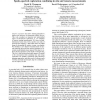Free Online Productivity Tools
i2Speak
i2Symbol
i2OCR
iTex2Img
iWeb2Print
iWeb2Shot
i2Type
iPdf2Split
iPdf2Merge
i2Bopomofo
i2Arabic
i2Style
i2Image
i2PDF
iLatex2Rtf
Sci2ools
AAAI
2015
2015
Spatio-Spectral Exploration Combining In Situ and Remote Measurements
Adaptive exploration uses active learning principles to improve the efficiency of autonomous robotic surveys. This work considers an important and understudied aspect of autonomous exploration: in situ validation of remote sensing measurements. We focus on highdimensional sensor data with a specific case study of spectroscopic mapping. A field robot refines an orbital image by measuring the surface at many wavelengths. We introduce a new objective function based on spectral unmixing that seeks pure spectral signatures to accurately model diluted remote signals. This objective reflects physical properties of the multi-wavelength data. The rover visits locations that jointly improve its model of the environment while satisfying time and energy constraints. We simulate exploration using alternative planning approaches, and show proof of concept results with the canonical spectroscopic map of a mining district in Cuprite, Nevada.
| Added | 27 Mar 2016 |
| Updated | 27 Mar 2016 |
| Type | Journal |
| Year | 2015 |
| Where | AAAI |
| Authors | David Ray Thompson, David Wettergreen, Greydon T. Foil, P. Michael Furlong, Anatha Ravi Kiran |
Comments (0)

